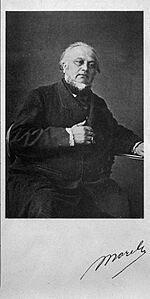Bénédict Morel facts for kids
Quick facts for kids
Bénédict Morel
|
|
|---|---|

Bénédict Morel
|
|
| Born | 22 November 1809 |
| Died | 30 March 1873 (aged 63) Saint-Yon, France
|
| Nationality | French |
| Scientific career | |
| Fields | psychiatry |
Bénédict Augustin Morel (born November 22, 1809 – died March 30, 1873) was a French doctor who studied the mind. He was born in Vienna, Austria. Morel was a very important person in the field of degeneration theory in the mid-1800s.
Who Was Bénédict Morel?
Morel was born in Vienna, Austria in 1809. His parents were French. When he was young, his parents left him after a big war. He was then raised by a kind man named Abbé Dupont and his helper, Marianne.
Morel studied in Paris. To earn money while he was a student, he taught English and German. In 1839, he became a medical doctor. Two years later, he started working with another important psychiatrist, Jean-Pierre Falret, in Paris.
Morel became even more interested in studying the mind in the 1840s. He visited many hospitals for people with mental health challenges across Europe. In 1848, he became the director of a special hospital in Nancy. There, he made important changes to help patients. For example, he made rules to use less physical restraints on people. At this hospital, he studied people with mental health issues. He looked into their family backgrounds and how things like poverty or childhood illnesses might have affected them. In 1856, he became the director of another mental hospital in Saint-Yon near Rouen.
Morel believed that mental health problems could get worse over time, from childhood to adulthood. In the 1850s, he created a theory called "degeneration." This theory tried to explain how mental problems developed. In 1857, he published a book where he explained his ideas about human degeneration. Morel thought that mental health issues could be passed down through families.
Morel's Degeneration Theory
Morel is most famous for his degeneration theory, which he developed in the 1850s. He started thinking about this theory while working at the mental hospital in Saint-Yon. In the 1800s in France, there seemed to be more sickness and mental health problems. Morel wanted to find out why.
Morel noticed that some patients in the hospital who had intellectual disabilities also had unusual physical traits. He expanded this idea, thinking that most people in the hospital had some kind of unusual physical feature.
Morel's degeneration theory suggested that mental health problems and other unusual behaviors came from an "abnormal constitution." He believed there was a "perfect" type of human, and that "degenerations" were changes away from this perfect type. He thought these changes could be inherited, meaning they were passed down through families. He also believed that these problems would get worse with each new generation. For example, he thought the first generation might have mild nervous problems. The next generation might have more serious mental health issues. The third generation might have severe intellectual disabilities. And the fourth generation, he believed, would be unable to have children.
In Morel's theory, "degeneration" meant anything that was different from a normal or healthy state. He thought these differences could be caused by things in the environment, like poor diet or illnesses. He also believed they could be passed down through families. Because of his "law of progressivity," he thought these problems would get worse in each generation. Eventually, he believed, families with these problems would die out because later generations would be too unwell to reproduce. Morel thought that the most serious "degenerative" illness was insanity. He divided degenerations into four main types: hysteria, moral insanity, imbeciles, and idiots.
In 1857, Morel published his book explaining his degeneration theory. In his book, he included pictures of patients. These pictures showed physical traits he believed were signs of degeneration. These included unusual ear shapes, uneven faces, extra fingers or toes, and high-arched palates. He thought these physical signs were linked to mental and moral problems.
Morel's ideas were well-received at the time. His theory connected mental health medicine with general medicine. It offered a scientific reason for why people had mental health problems. It also gave doctors an explanation when they couldn't help their patients get better. Morel's theory suggested that some mental health problems were genetic and couldn't be cured. His ideas quickly spread across Europe. Important figures like Wilhem Griesinger in Germany, Valentin Magnan in France, and Cesare Lombroso in Italy helped spread his theory. By the 1880s, Morel's degeneration theory was very important in French psychiatry.
Morel's Impact
Morel is seen as a key figure in the history of mental health studies. His ideas helped people understand mental illness when it was becoming more common in France in the 1800s and early 1900s. Morel's degeneration theory quickly became popular across Europe. It influenced later scientific ideas, including theories about body types and Lombroso's ideas about how physical traits might relate to behavior.
However, Morel's theory also had some negative impacts. It was used to support ideas like eugenics, which is the idea of trying to "improve" the human race by controlling who can have children. This was later used in harmful ways, like by the Nazis.
Not all thinkers agreed with Morel's work. Famous figures like Sigmund Freud and Karl Jaspers rejected his ideas. Even though Morel's degeneration theory is now considered outdated by modern doctors, he is still recognized for helping to create a more biological way of looking at mental health problems.

